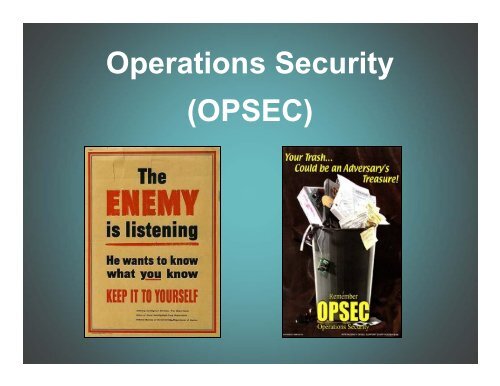Operations Security (OPSEC) - NCMS - Antelope Valley Chapter
Operations Security (OPSEC) - NCMS - Antelope Valley Chapter
Operations Security (OPSEC) - NCMS - Antelope Valley Chapter
You also want an ePaper? Increase the reach of your titles
YUMPU automatically turns print PDFs into web optimized ePapers that Google loves.
<strong>Operations</strong> <strong>Security</strong>(<strong>OPSEC</strong>)
<strong>OPSEC</strong> ….• Background• What is it?• Why do we need it?• Who should use it?• Goal• Key Terms• The 5-Step Process• <strong>OPSEC</strong> Applications
<strong>OPSEC</strong> Background• National <strong>Security</strong> Decision Directive (NSDD) 298,identified and formalized the five-step <strong>OPSEC</strong>process.• NSDD 298 required all executive departments andagencies, with national security operations, and thecontractors that support them, to establish <strong>OPSEC</strong>programs.• Interagency <strong>OPSEC</strong> Support Staff (IOSS) wasestablished to direct and support this directive.
What is <strong>OPSEC</strong>?Definition:A systematic proven process to identify, controland protect generally sensitive but unclassifiedinformation about a mission, operation or activityand thus denying or mitigating an adversary’sability to compromise or interrupt that mission,operation or activity.
Why do we need <strong>OPSEC</strong>?• To ensure mission effectiveness• To protect critical information• To protect the integrity of a mission• To maintain an element of surprise<strong>OPSEC</strong> looks at critical information from both afriendly and adversary perspective.
Who should use <strong>OPSEC</strong>?<strong>OPSEC</strong> can be used by the military, governmentinstitutions, corporations, schools, communities andindividuals.<strong>OPSEC</strong> can be used for but not limited to the following:• Planning and Forecasting special events• Special Training Exercises• Standard Operating Procedures• Methods, Sources, and Technical Tradecraft• At home and on vacation• Contracts/Bidding Processes• Software and Source Code
<strong>OPSEC</strong> GoalTo control information about your organization’scapabilities and intentions in order to keep themfrom being exploited by your adversaries.<strong>OPSEC</strong> does not replace other security disciplines;it supplements them.
Key Terms1. Critical Information – Specific facts about friendlyoperations, needed by an adversary, in order to plan,act and guarantee failure of your mission.2. Adversary – An opponent who opposes your interestand who must be denied critical information of yourmission (the bad guy).3. Threat – The capability and intent of an adversary toundertake actions that will be detrimental to thesuccess of your operation.4. Indicator – Observable activities or clues that canreveal sensitive information about your operation.Indicators can be exploited by an adversary and usedto their advantage.
Key Terms (cont’d)5. Vulnerability – A weakness that can be exploited byan adversary to obtain critical information about yourmission.6. Risk – The probability that an adversary willcompromise your critical information, and the impactthe act will have on your mission.7. Countermeasure (CM) – Anything that effectivelynegates or reduces an adversary’s ability to exploit yourvulnerabilities.
The 5 Steps of <strong>OPSEC</strong>The <strong>OPSEC</strong> 5-Step Process provides: a holisticpicture, a systematic process for mission successand an analytical methodology for assessingcritical information.1) Identify Critical Information2) Analyze Threats3) Analyze Vulnerabilities4) Assess Risk5) Apply Countermeasures
Step 1. Identify Critical InformationCritical Information is developed from analyzingboth friendly and adversary strategies to achieveobjectives.
Step 2. Analyze the Threat• Identify the potential adversary(s)• Identify intent and capabilities• Identify what the adversary(s) already knows(public information)• Identify what the adversary(s) needs to know• Identify where the adversary(s) may look to obtaincritical information of your operation
Step 3. Analyze VulnerabilitiesSome examples of vulnerabilities are:• Lack of training• Use of non-secure communications• Publishing VIP itineraries• Poor system design
Step 3. Analyze Vulnerabilities (cont’d)Three indicator categories that can lead tovulnerabilities or reveal critical information:1. Patterns and daily routines can establish a profile2. Sudden change in normal conduct; deviations3. Tip-off indicators show an adversary where to focusattention
Step 4. Assess RiskRisk has three components:Threat x Vulnerability x Impact = RiskAdversary’s intentWeakness givingadversary anopportunityNegativeconsequenceson a missionThreatThreatRiskNoRiskVulnerabilityImpactVulnerabilityImpact** All Three Components Must Be Present For Risk To Exist **
Step 4. Assess Risk (cont’d)Risk Assessment is the decision-making step,once a vulnerability has been detected, todetermine if countermeasures should be applied.Two methods used to assess risk:1. Intuitive Reasoning Approach – gained from personalexperience2. Committee Approach (preferred method) – several peoplelook at the same problem and determine the answercollectively
Step 5. Apply CountermeasuresExamples of Countermeasures:1. Changes in standard / routine procedures.2. Limit distribution to ONLY those who need it foroperational use.3. Cover and Deception can conceal the nature of themission, but is difficult to implement and sustain - alsovery costly.4. Accelerate the schedule.5. Awareness training for all personnel. Know andunderstand the threat and how to protect criticalinformation from potential adversaries.
Step 5. Apply CM (cont’d)A combination of low-cost countermeasures arethe best overall protection.** ALWAYS weigh the Cost vs. the Benefit **
<strong>OPSEC</strong> Applications• Benefit day-to-day operations by making<strong>OPSEC</strong> practices ‘second nature’ to allpersonnel.• Lessen contingencies by reducing indicators andavoiding tip-offs.• Increase early detection when used in theplanning phase of a task.• Allows for change in procedures over time,through surveys.
“The number of known adversaries conductingresearch on information attacks is increasingrapidly and includes intelligence services,criminals, industrial competitors, hackers anddisgruntled or disloyal insiders.”- George Tenet(Former Director, CIA)
REMEMBERProtecting YOUR information is YOUR responsibility!!“In wartime, the truth is so precious that it must beprotected by a bodyguard of lies.”– Winston Churchill


